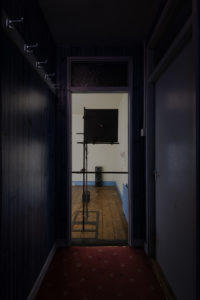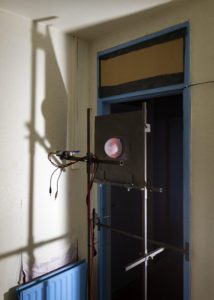Review | The Paradise of the Heart @ TACTIC Gallery
In the words of Franco ‘Bifo’ Berardi, ‘Dystopic irony means something which is at the same time euphoric and depressed, dark and light.’ The same can be said for the works for both Tomas Penc and Peter Nash in their exhibition just passed in TACTIC Gallery, Cork The Paradise of the Heart. The spectre of the digital age and the anxiety it produces hangs over the exhibition like a dark cloud and yet, here in this pair of dilapidated houses within a fort in the heart of Cork city there can also be found moments of serenity and even humour.
In the year 1631 the Czech scholar John Amos Cornelius published his famous allegory The Labyrinth of the World, The Paradise of the Heart. A work of Baroque psychoanalytic literature, it tells the story of a pilgrim who goes out into the world in order to find peace but instead is faced with confusion and chaos. The book ends with the pilgrim heading home reflecting on the neglected safe-house of his own heart where he can finally begin to find peace, ‘I found not here rustle and rush, noise and crash, unrest and reeling to and fro, tussling and violence (things of which the world is full). Here everything was quiet.’
Almost four hundred years after the publication of The Labyrinth of the World on a blindingly bright and crisp Winter’s morning I walked into one of the beautifully dilapidated houses of Cork’s Elizabeth Fort, and was frightened out of my skin. Penc and Nash’s practices are both heavily invested in our relationship to contemporary technologies. In their shared world technology is dystopic and disembodied, a source of constant anxiety. There is an unbridgeable gulf between the virtual world and the physical and both bodies of work which make up Paradise of the Heart highlight this gap pushing it to extreme proportions.

Barking Dog Seldom Bites is the first work one encounters in the exhibition and the experience of it destroys any preconceived notions one might have about this show being the usual quiet contemplative gallery visit. Hidden behind a doorway in the cramped hall waiting for the unwary passer-by to trip its motion detector and emit its unearthly metallic growl, Barking Dog consists of a digital apparition of a ghostly canine projected on a screen. Despite the inevitable initial fright, however, a closer inspection of the room in which the sculpture exists reveals the apparition for what it is: we can even see the cables and amplification equipment that lie behind the screen. The dog, though seemingly vicious, is a harmless audio visual construct and once we have realised this it’s spell is broken and it holds no more fear for us. Here we can find hints of dystopian irony as the ephemerality of the digital is brought to light and after the shock one is left seeing the humour in the situation and it is a source of hope. The dog impinges on our sensual universe both audibly and visually but cannot physically harm us. Barking Dog Seldom Bites had me literally jumping at shadows.
Nash’s practice too is created in reaction to contemporary technologies and the ever increasing ready availability of information. Instead of concentrating on the failings of the virtual and its powerlessness in the physical realm Nash concentrates of the fallibility of human interpretation of data and the possibility for wonder and magic within this interpretation. Nash uses the incredibly time consuming process of wood carving openly defying digital societies insistence that time is our most limited and valuable resource and that to ‘waste it’ is the most dangerous sin one can commit.
Upon walking upstairs I was confronted with Nash’s Galvanic Interruption, a chorus of disembodied heads, mechanical automatons who periodically sing (or scream?) a silent chorus by way of a motor attached to many strings each of which is connected to the moving jaw bone of an individual head. At first glance this chorus of floating heads look like mass produced trinkets until a closer look reveals that each is a painstakingly hand carved copy of the next. The process of carving here, time consuming as it may be, illustrates the magic of human interpretation, each of these elements is utterly individual and bears the indexical imprint of the artists hand.
This theme is taken to its logical conclusion in the next room, where Domestic Animal consists of two elements, a two dimensional drawing of a cat’s skeleton in profile and a three dimensional hand carved model of a cat’s skeleton encased in a handmade vitrine. What Nash has done in this case is carved and assembled a three dimensional model of a cat’s skeleton using only this two dimensional anatomical profile as his source material, and in extruding this profile into a model the end product becomes not a physical representation of a cat but more so a literal representation of the human brain’s ability to take incomplete data and fill in the blanks to form a whole. It is at once an ode to the computational power of the human brain, and also a celebration of its inherent fallibility. A digital programme wouldn’t make the errors in scaling and assembly that can be found in this sculpture and it would be less rich because of this. Played off against the prowess of human ingenuity in this room are the flaws which make it so unique. The drawing of the cat’s anatomical profile that rests on the wall is annotated, not with the correct titles of each bone as one would assume, but with the many small anxieties that clearly come from within the artist’s psyche and yet are near universally relatable, ‘have you updated your CV recently?’, ‘recommended for you’, and ‘slumped on the couch at 9 o’clock poking at a smartphone’ are just a small selection of the multitude of anxieties that may well have been prodding at the sculptor during the long hours spent carving each individual bone of the cat’s vertebrae. All of this results in a gem of a sculpture that approaches the legitimate and at times overwhelming anxieties of being left behind by an information saturated society with skill and wit.

Recurring time and time again throughout the exhibition is the uncanny experience of looking through a portal into a different and dangerous place from the safety of these charming unkempt houses complete with peeling wallpaper and creaky floorboards. This space is a literal manifestation of Amos’s dilapidated yet comforting Paradise of the Heart and from it we can look out at the dangerous and turbulent labyrinth of the world. Upstairs in house number two Penc’s Hidden Potential is the best example of this. The last work encountered in the exhibition, walking down a darkened hallway towards the ominous cacophony of a beehive hard at work we are confronted with a peephole, the type found at a front door; it is typically safety device installed to protect ones home from the unknown by allowing the inhabitant to identify visitors who come knocking at the door without breaking the integrity of the home’s fortification. Through this hole another hallway can be seen to be continuing along the path but this virtual hallway (entirely CGI) is far more plush and luxurious than the one I find myself standing in. I can almost make out faint movements of what could be individuals at the far end of the hall looking back at me but cannot be sure. Suddenly the unseen hive that has been noisily bussing throughout the hallway comes to an abrupt stop and as silence descends so too do ashes, coating the luxurious virtual space in a dust, the dust of some unknowable catastrophe along with the now expansive silence. But just as with Barking Dog there is no reason to fear, what is happening in that virtual dimension is removed from mine own body and cannot invade the reality of my world. As this scene of disaster appears in silence through the peephole I was reminded of the passage quoted by the artist from Amos’ allegory, a passage which speaks about the safety and consolation to be found within the fortress of the mind ‘I found not here rustle and rush, noise and crash, unrest and reeling to and fro, tussling and violence (things of which the world is full). Here everything was quiet.’
The Paradise of the Heart is an exhibition that is in turns frightening, beautiful and funny. It is a literal manifestation of Amos’s psychological inner paradise realised in Bifo Berardi’s mode of dystopian irony. All works in the exhibition were created specifically for this space against the backdrop of an ongoing dialogue between the two artists and there is an obvious deep connection between the two bodies of work, despite the vast differences between Nash’s delicate carvings and Penc’s digital creations. I left this exhibition with a newfound perspective on the bizarre anxieties that eat at all of us in the digital age and, strangely though it may seem a small glimmer of hope for the future nestled in the safety of the inner sanctum of my own mind.
